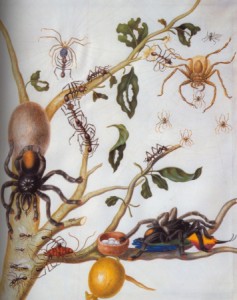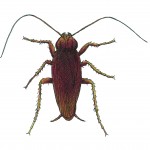READY TO GET STARTED?
REQUEST A FREE ESTIMATE
Fill out the form below or call (888) 466-7849 for a free, no-obligation estimate.
When you reflect on famous artists and their work, like the Mona Lisa by DaVinci for instance, you can immediately appreciate the beauty of their masterpiece. However, when the subject of an artwork is an insect, you might have a little more trouble seeing the beauty in it before wanting to call an exterminator! The brave souls who did make insects their muse had an appreciation for natural history, especially during the 17th century.
Studying bugs for their connection to the earth and nature led to some beautiful creations by Albrecht Dürer such as the Stag Beetle. Dürer said of art, “It is indeed true that art is omnipresent in nature, and the true artist is he who can bring it out.”
Some artists liked to focus on butterflies because they represented transformation and resurrection. Wenceslaus Hollar’s drawing Forty-One Insects, Moths and Butterflies features a collection of bugs of different varieties on displaying much like a “cabinet of curiosity.” Check out this painting and more below!

Maria Sibyla Merian, Branch of guava tree with leafcutter ants, army ants, pink-toed tarantulas, c. 1701-5
Melissa Brown
[email protected]
Source:
http://venetianred.net/2010/04/20/the-busy-bee-has-no-time-for-sorrow-insects-in-art/
 For years, DEET has been the “go-to” insect repellant recommended by everyone from Doctors to pest control companies. But recently, reports have come out that although they deter insects at first, they learn to ignore it and will go on to bite anyways. Specifically, mosquitoes, are thought to be getting more and more resistant to the substance.
For years, DEET has been the “go-to” insect repellant recommended by everyone from Doctors to pest control companies. But recently, reports have come out that although they deter insects at first, they learn to ignore it and will go on to bite anyways. Specifically, mosquitoes, are thought to be getting more and more resistant to the substance.
It just goes to show how adaptive insects and animals really are. That is why Northwest Exterminating, and other pest control companies, need to constantly be on the cutting edge of technology.
You can read the full article by clicking here.
 Also known as Palmetto Bugs or Waterbugs, American Cockroaches are the largest cockroach in the U.S. American Cockroaches are considered one of the fastest running insects; they often dart out of sight when someone enters a room, and can fit into small spaces despite their large size. They have been known to fly, but it’s rare.
Also known as Palmetto Bugs or Waterbugs, American Cockroaches are the largest cockroach in the U.S. American Cockroaches are considered one of the fastest running insects; they often dart out of sight when someone enters a room, and can fit into small spaces despite their large size. They have been known to fly, but it’s rare.
Identification
Environment
Threats
Treatment
If you spot evidence of cockroaches call a licensed pest professional like Northwest Exterminating as soon as possible. American cockroaches can lay 10 or more egg cases, each containing 14-16 eggs. You don’t want this infestation to get out of hand.
We recently celebrated Valentine’s day, a time of year when couples make sure to let each other know just how much love there is between them. But when we talk about the kissing bug, we don’t mean the kind you get from your sweetie. Kissing bugs, also known as conenose bugs, assassin bugs, or triatomines, get their name from choosing to bite their victims close to the mouth, possibly due to their attraction to the carbon dioxide coming from a mammal’s breath.
Adult bugs are about 6/8 inch long and range in color from dark brown to black, wings and six equally-spaced reddish-orange spots. Kissing bugs also occur in and around homes, where they feed on the blood of humans, rats and other animals. Additionally, they feed on other pests – including other kissing bugs! During the day they take refuge, but at night time they search for blood when their host is asleep and the air is cooler.
In the southern United States, on rare occasions, some of these bugs transmit Chaga’s disease among their victims. Rather than transmitting it through its saliva as most would assume, kissing bugs transmit this to humans via its feces. It can also be spread from human to human via blood transfusion and organ transplantation, ingestion of infected food and from mother to fetus. Mild symptoms include fever, fatigue, body aches, headache, and rash, loss of appetite, diarrhea, and vomiting.
Though rare in this part of the United States, if you spot these bugs, you know exactly who to call – Call the mouse!
Melissa Brown
[email protected]
Sources:
https://insects.tamu.edu/fieldguide/aimg53.html
Humans and pets aren’t the only things getting groomed. Researchers at NC State explain why cockroaches spend so much time in the grooming department. Read below…
Like a self-absorbed teenager, insects spend a lot of time grooming. In a study that delves into the mechanisms behind this common function, North Carolina State University researchers show that insect grooming — specifically, antennal cleaning — removes both environmental pollutants and chemicals produced by the insects themselves.
The findings, published online this week in Proceedings of the National Academy of Sciences, show that grooming helps insects maintain acute olfactory senses that are responsible for a host of functions, including finding food, sensing danger and even locating a suitable mate.
The findings could also explain why certain types of insecticides work more effectively than others.
Insects groom themselves incessantly, so NC State entomologist Coby Schal and post-doctoral researchers Katalin Boroczky and Ayako Wada-Katsumata wanted to explore the functions of this behavior.
Click here to read the entire article.
Source: Science Daily